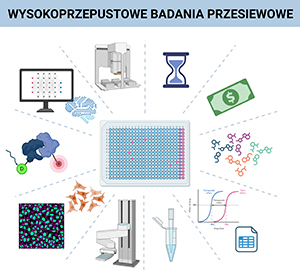The role and application of high-throughput screening in the search for chemical compounds of therapeutic activity
DOI:
https://doi.org/10.18388/pb.2021_528Abstract
With the development of medicine and the aging population, the demand for more effective therapies is escalating. A tool that facilitates the discovery and introduction of new therapeutic drugs is High-Throughput Screening (HTS). These tests, consisting of a wide set of various assays, allow testing hundreds of thousands of compounds in a short period of time. The aim is to accurately identify active compounds that could become potential therapeutic candidates in the pharmaceutical industry. HTS is the first step in the quest for potential drugs, therefore it is one of the crucial tests that determine whether a particular drug candidate will be discovered. In this review, different stages of high-throughput screening studies will be described, as well as methods utilized in these studies. The necessary steps in the optimization of these tests, selection of equipment, automation and key quality control parameters for reliably performed screening will also be presented.
Published
License
Copyright (c) 2024 Natalia Karczewska, Monika Pyc, Krzysztof Żukowski, Joanna Kosman, Dorota Kwiatek, Jacek Kolanowski

This work is licensed under a Creative Commons Attribution 4.0 International License.
All journal contents are distributed under the Creative Commons Attribution-ShareAlike 4.0 International (CC BY-SA 4.0) license. Everybody may use the content following terms: Attribution — You must give appropriate credit, provide a link to the license, and indicate if changes were made, ShareAlike — If you remix, transform, or build upon the material, you must distribute your contributions under the same license as the original. There are no additional restrictions — You may not apply legal terms or technological measures that legally restrict others from doing anything the license permits.
Copyright for all published papers © stays with the authors.
Copyright for the journal: © Polish Biochemical Society.



